Please note that this post contains affiliate links to find out more information, read my disclosure policy for more information.
Space comes at a premium, so it’s a need to maximize every square inch of your living area as it’s not only a matter of style but also a necessity. Small spaces can be cozy, efficient, and brimming with character, provided you know the right tricks to make them work for you. If you’ve been struggling with the challenge of decorating a compact home, you’re in the right place.
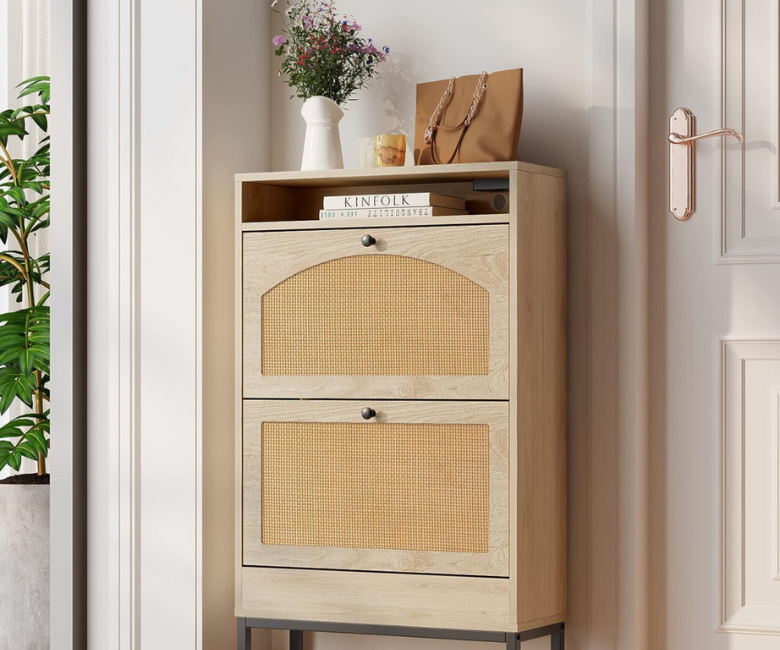
Small spaces demand creativity and thoughtful design, and our tips encompass everything from smart storage solutions to the clever use of color and furniture. With these strategies, you’ll not only make the most of your space but also create an environment that feels open, organized, and inspiring.
Whether you’re living in a studio apartment, a cozy cottage, or just want to make better use of a compact room, these ideas are universally applicable. Get ready to unlock the potential of your small space and transform it into a place that’s both beautiful and functional.
1. Declutter and Organize: Start by getting rid of items you don’t need and organizing what’s left to create more space.
In the quest to make the most of those cozy living areas, decluttering and organizing become paramount. It’s time to bid farewell to those items you don’t really need and create a space that exudes tranquility and spatial efficiency. So, roll up your sleeves, put on your favorite tunes, and let’s get down to business!
Start by taking a good look at every nook and cranny of your small space. Identify those items that have been collecting dust or serving no significant purpose in your daily life. Take a deep breath because we’re about to transform chaos into order! Begin by categorizing your belongings into different groups based on their function or purpose: books, electronics, clothing, kitchenware—the possibilities are endless!
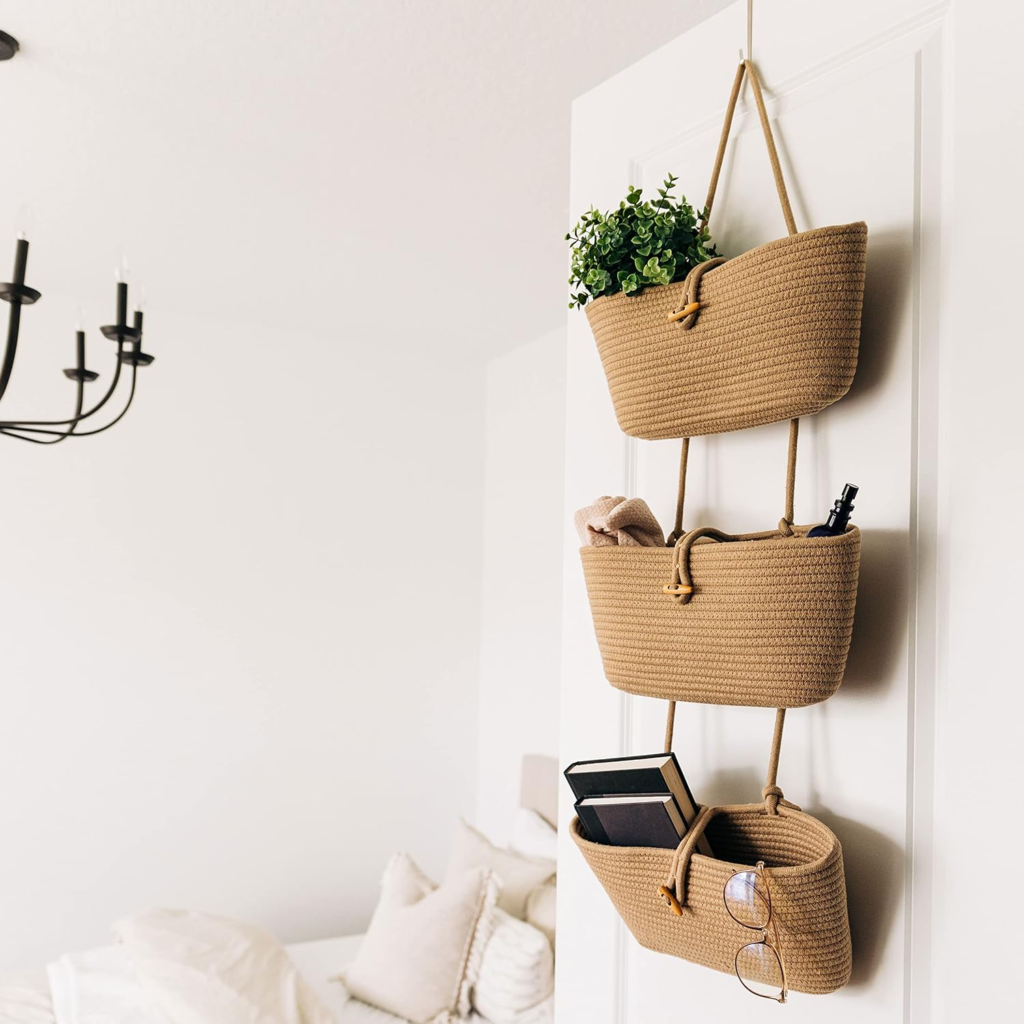
Shop this Woven Hanging Baskets for Organizing from Amazon
By grouping similar items together, you’ll create an intuitive system that makes finding what you need a breeze. Now that everything is neatly sorted into categories, let’s find suitable storage solutions.
Investigate every inch of available space—under beds, inside closets, even those high shelves—that could be utilized more efficiently. Invest in stylish storage bins or baskets that can slide under furniture or modular shelving units with various compartments.
To maximize storage potential further, consider using vertical space wisely. Place floating shelves along walls or hang wall-mounted organizers with hooks for keys and accessories near your entryway.
2. Multifunctional Furniture: Invest in furniture that serves multiple purposes, like a sofa bed or a storage ottoman.
When it comes to decorating small spaces, one key element to consider is investing in furniture that serves multiple purposes. Multifunctional furniture not only maximizes space but also adds versatility and convenience to your living area. So, let’s delve into the world of these ingenious pieces that can transform your compact space into a highly functional oasis.
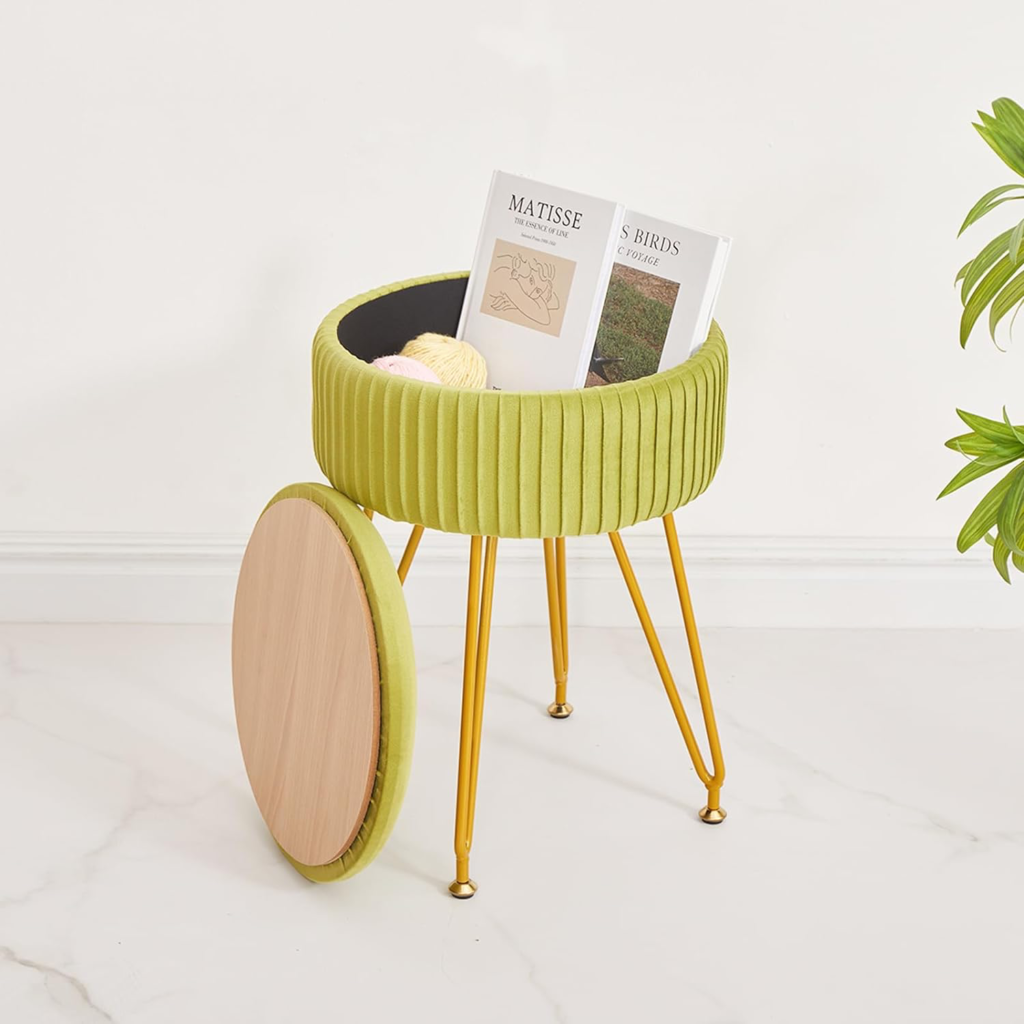
Shop this Vanity Stool with Storage from Amazon
Modern sofa beds are designed with style and comfort in mind, allowing you to seamlessly transition from a cozy couch during the day to a comfortable bed at night. Whether you have guests staying over or need an extra sleeping option for yourself, this multipurpose furniture piece is a game-changer in small spaces.
Look for models with built-in storage compartments as an added bonus for keeping extra bedding or pillows neatly tucked away. Another multifunctional gem is the storage ottoman.
Not only does it offer a comfy place to rest your feet after a long day but also provides much-needed storage space. You can find ottomans with removable tops that reveal hidden compartments where you can stash away blankets, magazines, or any other items cluttering up your space.
From beds with built-in storage and dining tables that expand to accommodate more guests to bookshelves that double as room dividers, there are numerous options available to suit your specific needs and style preferences. Remember, in small spaces, every square inch counts, so make sure to invest in furniture that serves multiple purposes and makes the most of your limited square footage.
3. Use Vertical Space: Utilize wall shelves and tall bookcases to make the most of vertical space.
When it comes to decorating small spaces, one of the most effective strategies is to make use of vertical space. This means taking advantage of those often underutilized walls by incorporating wall shelves and tall bookcases.
By going vertical, you can maximize storage and display options without sacrificing valuable floor space. Wall shelves are a fantastic way to add both functionality and style to your small space.
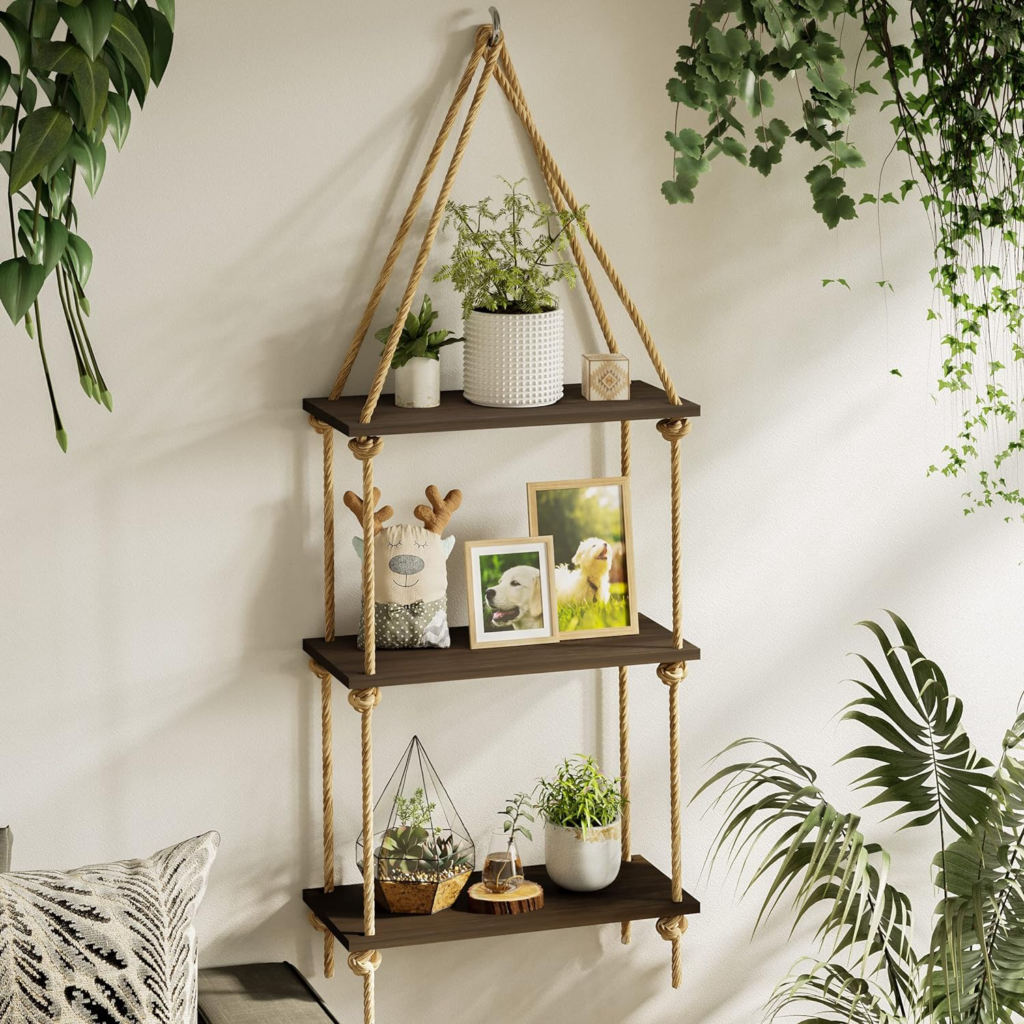
Shop this Hanging Wall Shelves from Amazon
Whether you opt for floating shelves or ones with brackets, they provide a practical solution for storing books, displaying decorative items, or even showcasing your favorite plants. Consider installing them above a desk or in the living room to create a focal point and make use of otherwise empty wall space.
Start by organizing books and decorative pieces on the shelves according to size, color coordination, or subject matter if you prefer a more curated look. Experiment with different arrangements until you find one that suits your aesthetic preferences while still being practical in terms of accessibility.
Remember, utilizing vertical space is not limited to just shelves and bookcases – think outside the box! Install hooks on the walls for hanging bags or coats, utilize hanging organizers in closets or behind doors for additional storage options.
The key is to make every inch count in your small space by finding creative ways to take advantage of those vertical surfaces that often go unnoticed. By incorporating wall shelves and tall bookcases into your home decor strategy for small spaces, you can transform previously unused areas into functional and visually appealing zones.
4. Light Colors: Choose light, neutral colors for walls and furniture to make the space feel open and airy.
When it comes to decorating small spaces, one of the most effective tricks in the book is to use light colors. Light and neutral hues can work wonders in making your space feel open, bright, and airy. So, bid farewell to dark and gloomy shades and embrace a palette that will give your small space a new lease on life!
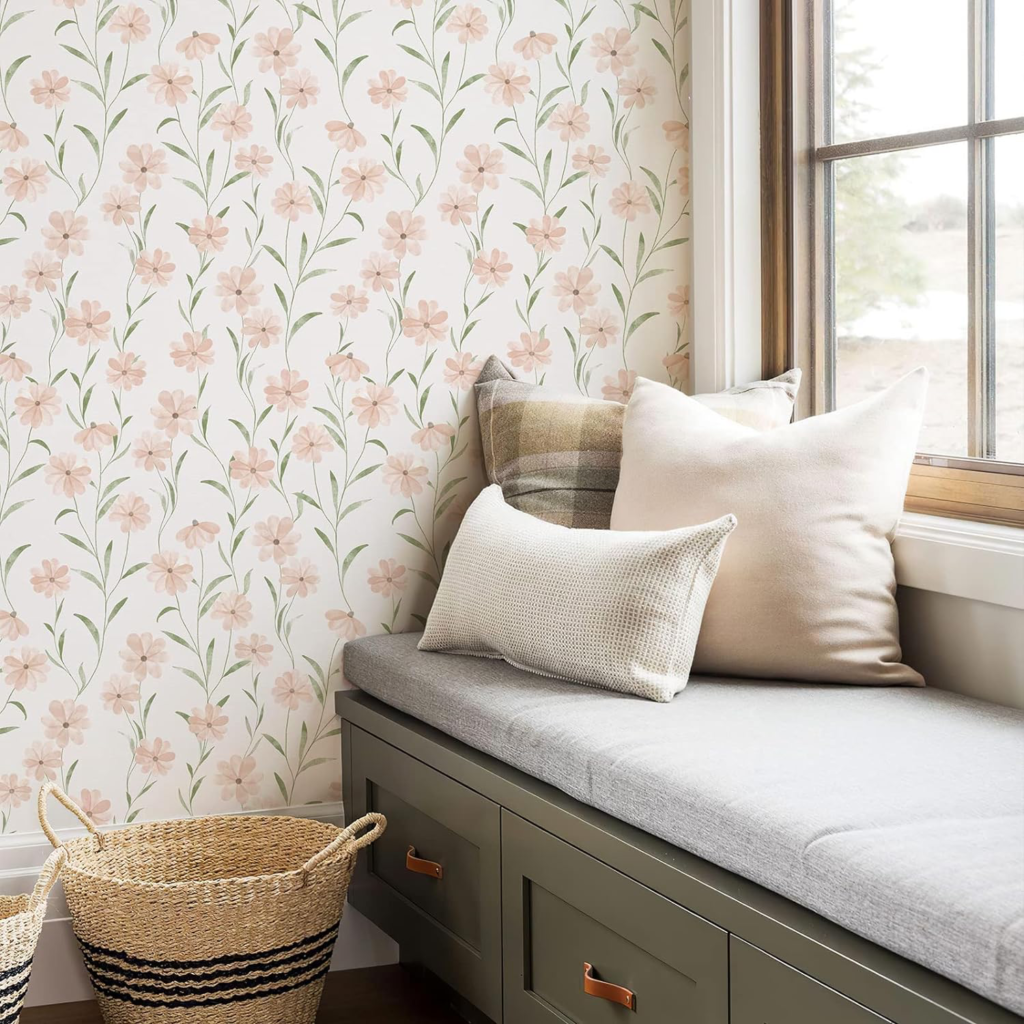
Shop this Floral Wallpaper Peel and Stick from Amazon
When choosing colors for your walls, opt for soft whites, creamy beiges, or delicate pastels. These light tones not only reflect natural light but also create an illusion of spaciousness. Light-colored sofas or armchairs can create an inviting atmosphere while visually expanding the perceived size of the area. To add depth and dimension to your space, experiment with different shades of white or beige for furniture upholstery.
Remember that lighting plays a significant role in how color is perceived within a room. Take advantage of natural light by keeping window treatments minimal or utilizing sheer curtains that allow sunlight to filter through gently during the day.
In terms of artificial lighting, opt for warm-toned bulbs rather than cool ones as they create a cozy ambiance while enhancing lighter color schemes. By embracing light colors throughout your small space – from walls to furniture – you’ll effortlessly create an environment that feels bright and open even when square footage is limited.
So go ahead and paint those walls in soft creams, dress your sofas in gentle hues, and add light-toned accessories that tie the look together. Soon enough, you’ll have a small space that feels refreshingly spacious and inviting.
5. Mirrors: Use mirrors to create the illusion of more space and reflect light.
Mirrors are a secret weapon when it comes to decorating small spaces. Not only do they add a touch of elegance and style, but they also have the magical ability to create the illusion of more space.
By strategically placing mirrors in your small room, you can make it feel larger and more open. One way to use mirrors is by hanging a large mirror on one of the walls.
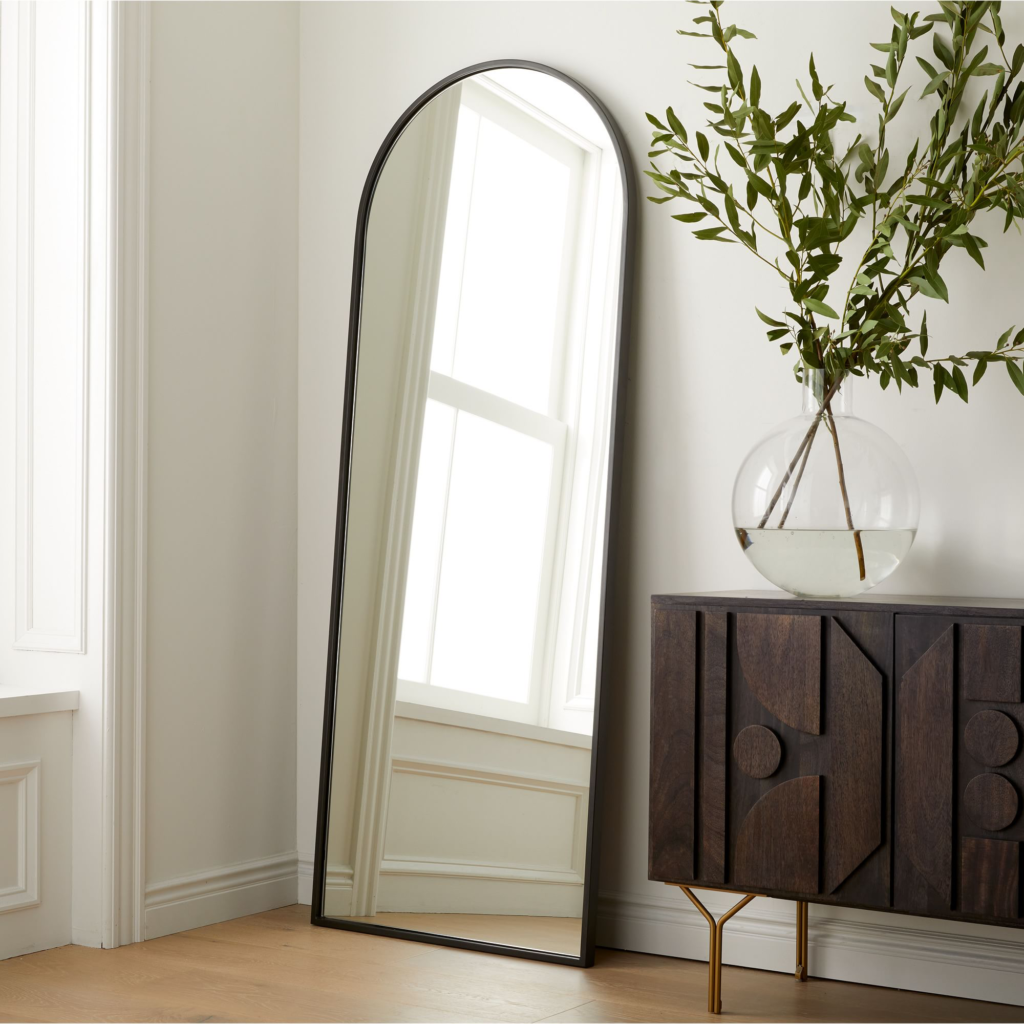
Shop this Arched Floor Mirror from West Elm
This will instantly make the room appear bigger as it reflects both natural and artificial light, giving an airy and spacious feel. You can choose a statement mirror with an interesting frame that adds character to the space or opt for a minimalistic frameless mirror for a sleek look.
If you have limited wall space, consider using mirrored furniture instead. A mirrored coffee table or side table can create depth in a small living room while reflecting light from nearby windows or lamps.
Additionally, mirrored furniture adds a glamorous touch to any space and gives off an illusion of floating furniture, making your room seem less cramped. Another clever trick is to hang mirrors opposite windows or doorways.
This will not only bounce natural light around the room but also create the illusion that there are additional windows or doors leading out into other areas. It’s like having multiple views into different dimensions!
Remember that when it comes to using mirrors for small spaces, placement is key! The right positioning allows them to maximize their potential in creating an illusion of spaciousness while brightening up the area by reflecting light sources.
Experiment with different sizes and styles until you find what works best for your space. With mirrors, you can transform your small room into a visually expanded sanctuary that feels open and inviting.
6. Open Shelving: Replace closed cabinets with open shelves to make the room feel more spacious.
One of the best ways to create a sense of openness and expansiveness in a small space is by replacing closed cabinets with open shelves. Closed cabinets can make a room feel cramped and claustrophobic, whereas open shelving allows for visual transparency and gives the illusion of more space.
Plus, open shelves provide an opportunity to showcase your favorite items and add a touch of personality to your decor. When incorporating open shelving into your small space, it’s important to strike a balance between functionality and aesthetics.
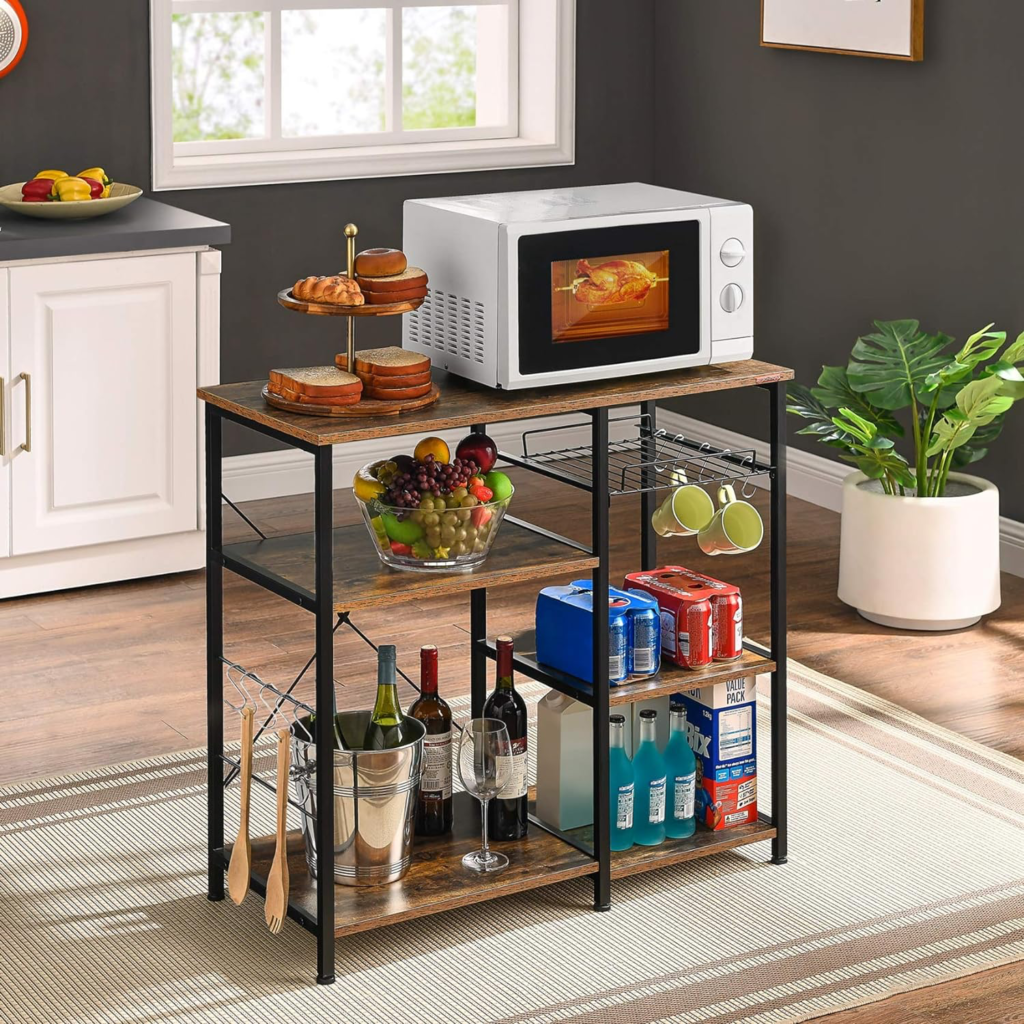
Shop this Bakers Rack from Amazon
Consider using floating shelves that don’t take up valuable floor space or opt for slim-profile wall-mounted units that blend seamlessly with the surrounding walls. These options not only maximize storage capacity but also create an airy, minimalist look that makes your room appear larger than it actually is.
To ensure that your open shelving doesn’t become overwhelming or cluttered, thoughtfully curate what you display on them. Instead of cramming every nook and cranny with miscellaneous items, choose a few statement pieces or decorations that will catch the eye.
This not only saves time but also encourages organization as you’ll naturally prioritize keeping things tidy since they are always on display. Open shelving can truly transform a small space by opening up both visual and physical dimensions.
By replacing closed cabinets with these sleek alternatives, you can create an inviting atmosphere while maximizing storage capacity without sacrificing style or functionality. So go ahead – embrace the beauty of openness and let your shelves tell a story.
7. Folding Furniture: Opt for folding tables and chairs that can be tucked away when not in use.
When it comes to small spaces, one of the most practical solutions is to opt for folding furniture. These versatile pieces are designed to be easily tucked away when not in use, providing you with the flexibility and freedom to maximize your space.
They are lightweight, compact, and easy to store away when not in use. From traditional wooden designs to modern metal frames with padded seats, there is a wide range of options available to suit your style and comfort preferences.
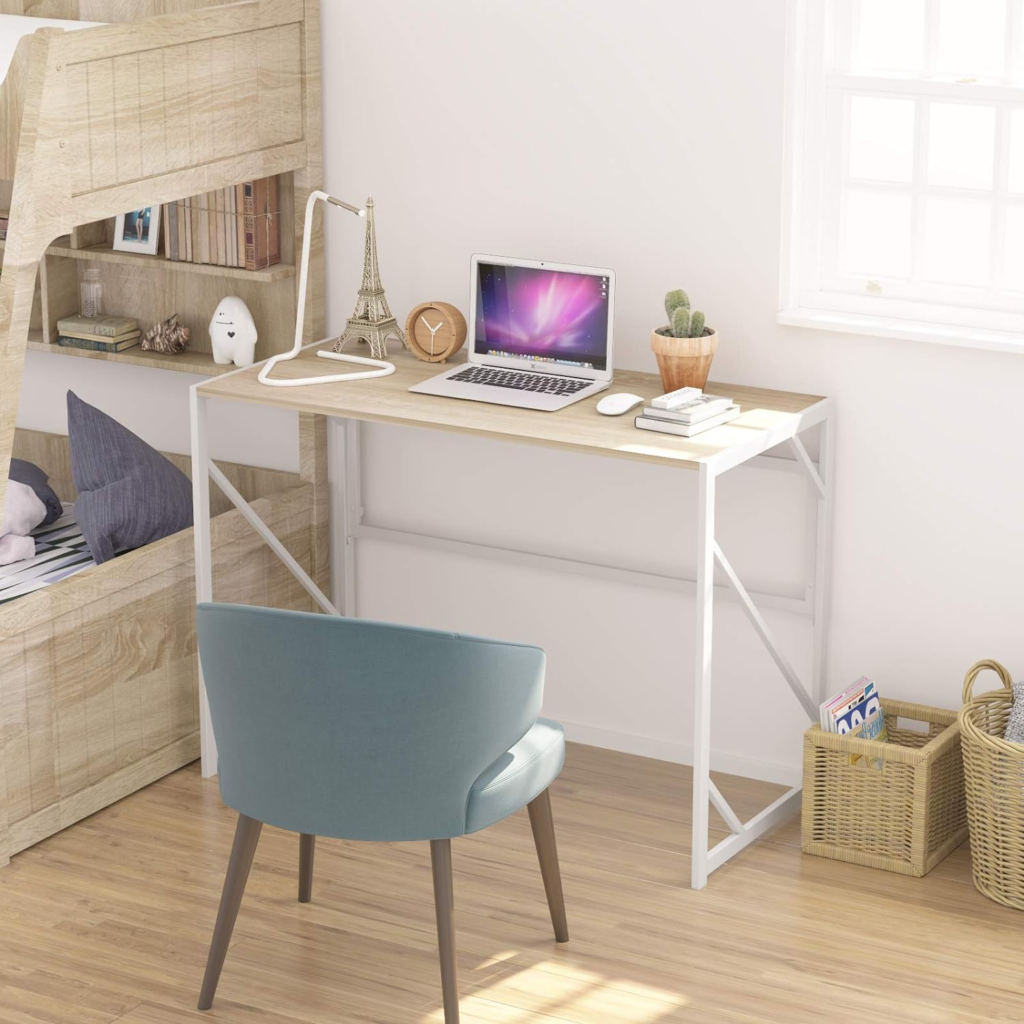
Shop this Folding Desk Writing from Amazon
If you’re short on space but still want an area where you can relax and unwind outdoors, consider investing in foldable outdoor furniture. Folding lounge chairs and picnic tables are perfect for small balconies or patios.
You can easily set them up when the weather is nice and fold them away during harsher seasons or when they’re not being used frequently. Don’t overlook the convenience of foldable storage solutions.
Folding storage ottomans serve as both extra seating options and discreet places to tuck away essentials like blankets or toys. They add functionality while keeping clutter at bay—a win-win situation!
Choosing folding furniture is an excellent strategy for optimizing limited space. Whether you’re looking for a versatile dining table, compact chairs, outdoor seating, or clever storage options, folding furniture offers practicality without sacrificing style.
8. Hidden Storage: Look for furniture with hidden storage compartments to keep clutter out of sight.
Having a small space doesn’t mean you have to sacrifice on storage options. In fact, it’s the perfect opportunity to get creative and find furniture that serves multiple purposes. Look out for pieces that offer hidden storage compartments to keep your space organized and clutter-free.
One of the most popular furniture choices with hidden storage is ottomans. These versatile pieces not only provide a place to rest your feet or act as an extra seat, but they also have a hollow interior where you can store items like blankets, pillows, or even board games.
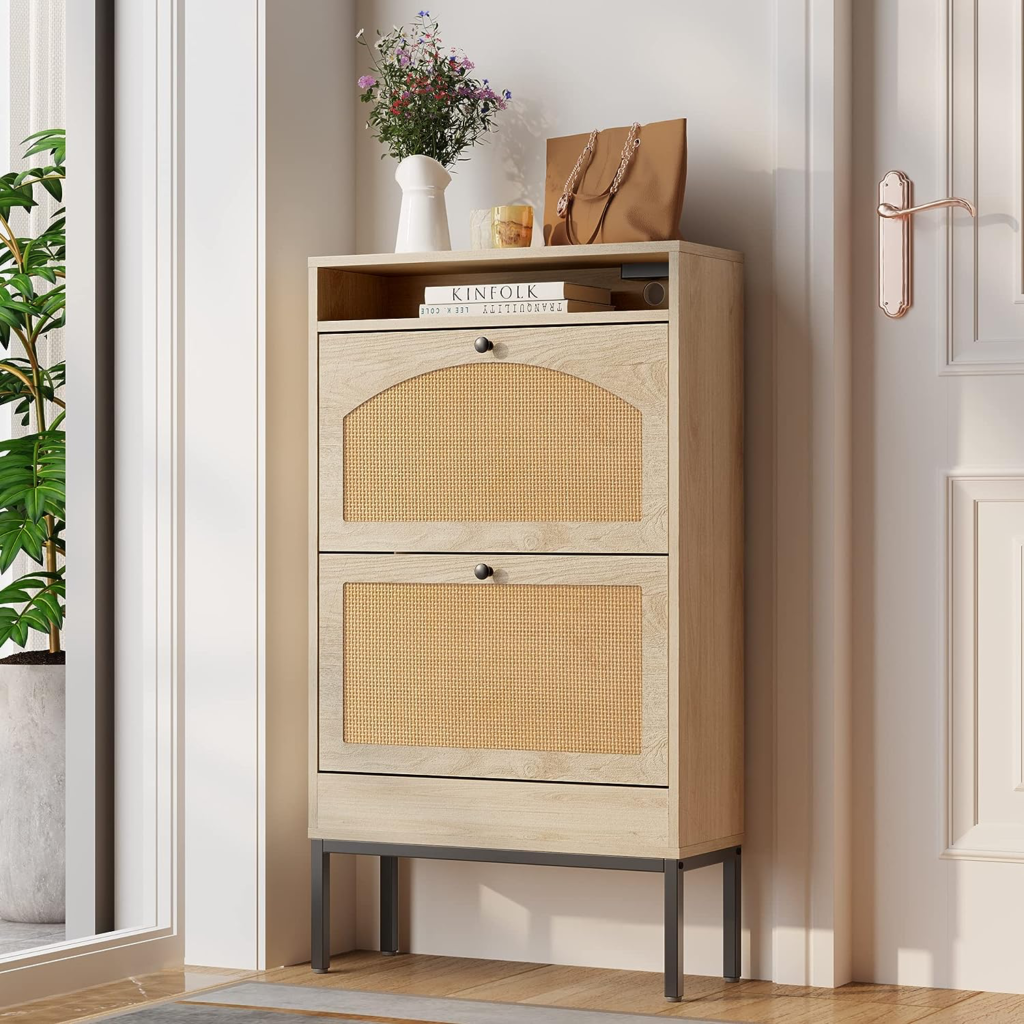
Shop this Rattan Shoe Cabinet from Amazon
For those with small entryways or mudrooms, look for benches with hidden storage cubbies underneath the seat. This way, you’ll have a comfortable spot to sit while putting on shoes or taking them off, while also having a designated place for storing things like hats, scarves, gloves, and other outdoor accessories.
When searching for furniture with hidden storage options, think about what items you need easy access to versus what can be tucked away out of sight. By utilizing these clever pieces of furniture in your small space design scheme, you’ll not only maximize your storage potential but also maintain a clean and tidy environment free from unnecessary clutter.
9. Wall-Mounted Desks: Install a wall-mounted desk to create a workspace without taking up floor space.
If you’re living in a small space and still want to have a dedicated workspace, don’t fret! There’s a clever solution that will cater to your needs without cramping up your precious floor space.
Enter the wall-mounted desk, a genius piece of furniture that lets you create your mini office or study area without sacrificing legroom. Let’s dive into the amazing benefits and practical considerations of installing a wall-mounted desk in your cozy abode.
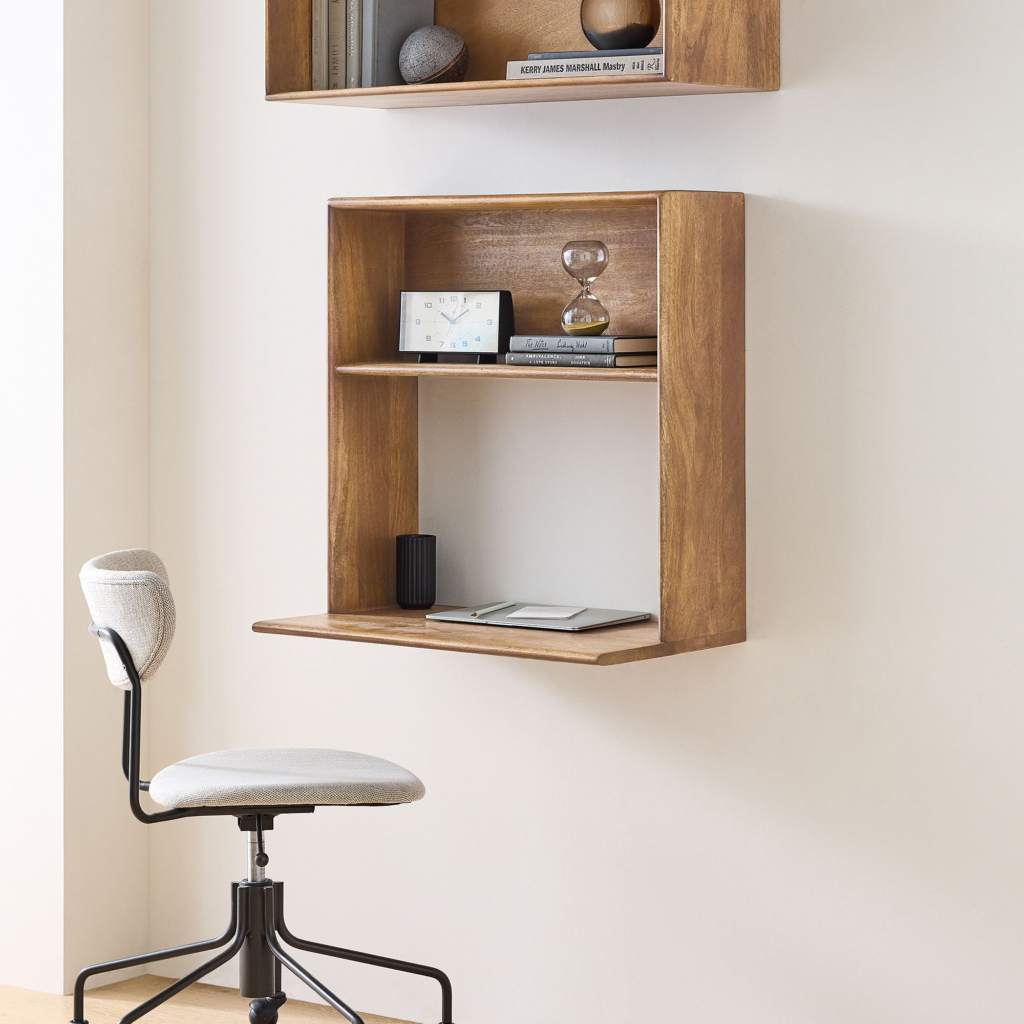
Shop this Anton Wall Mounted Desk from West Elm
Look for one with ample surface area to accommodate all your work essentials – whether it’s a laptop, notebooks, or even art supplies if you’re feeling creative! Consider additional features like built-in shelves or cubbies that allow for convenient storage of books and stationery within arm’s reach.
Installation-wise, it’s relatively simple! Most wall-mounted desks come with clear instructions and hardware needed for affixing them securely to the walls – typically using sturdy brackets or mounting systems.
Just ensure that you locate studs within the walls before drilling any holes for added stability. So there you have it – the magic of having a stylish and efficient workspace in small spaces, thanks to the wonders of wall-mounted desks.
10. Rugs: Use rugs to define different areas within a small space and add a touch of style.
When it comes to home decor, rugs are not only functional but also a fantastic way to elevate the style of your small space. In a compact area, rugs can be used as visual dividers, separating different zones within the room.

Get this Oliver Hand Tufted Rug from UO
Whether you’re living in a studio apartment or have an open floor plan, strategically placing rugs can create distinct areas for lounging, dining, or even working. To make the most of your small space with rugs, consider using contrasting colors or patterns that complement each other.
For instance, if you have a living area adjacent to a dining space, choose one rug with bold geometric patterns for the living area and another rug with subtle textures for the dining section. This visually distinguishes between the two spaces while maintaining an overall cohesive look.
Consider selecting rugs that incorporate colors from other elements in the room such as throw pillows or curtains. By doing so, you create a harmonious color palette that gives your small space an intentional and well-designed feel.
Don’t forget about texture when choosing rugs for your small space. Opt for materials like plush shaggy carpets for comfort underfoot or natural fibers like jute or sisal for an earthy and organic vibe.
By considering contrasting colors, mixing rug sizes and shapes, coordinating with existing decor elements, and incorporating different textures, you’ll be able to maximize the visual impact of rugs in your small space. So go ahead and get creative with rugs – they’re the perfect tool to define areas while adding an extra touch of style to your compact living quarters.
11. Curtains: Hang curtains close to the ceiling and use long, flowing curtains to make the room appear taller.
When it comes to making a small space appear larger, the right choice of curtains can work wonders. One effective trick is to hang your curtains close to the ceiling, rather than right above the window frame. By doing this, you create an illusion of height and make the room feel more spacious.
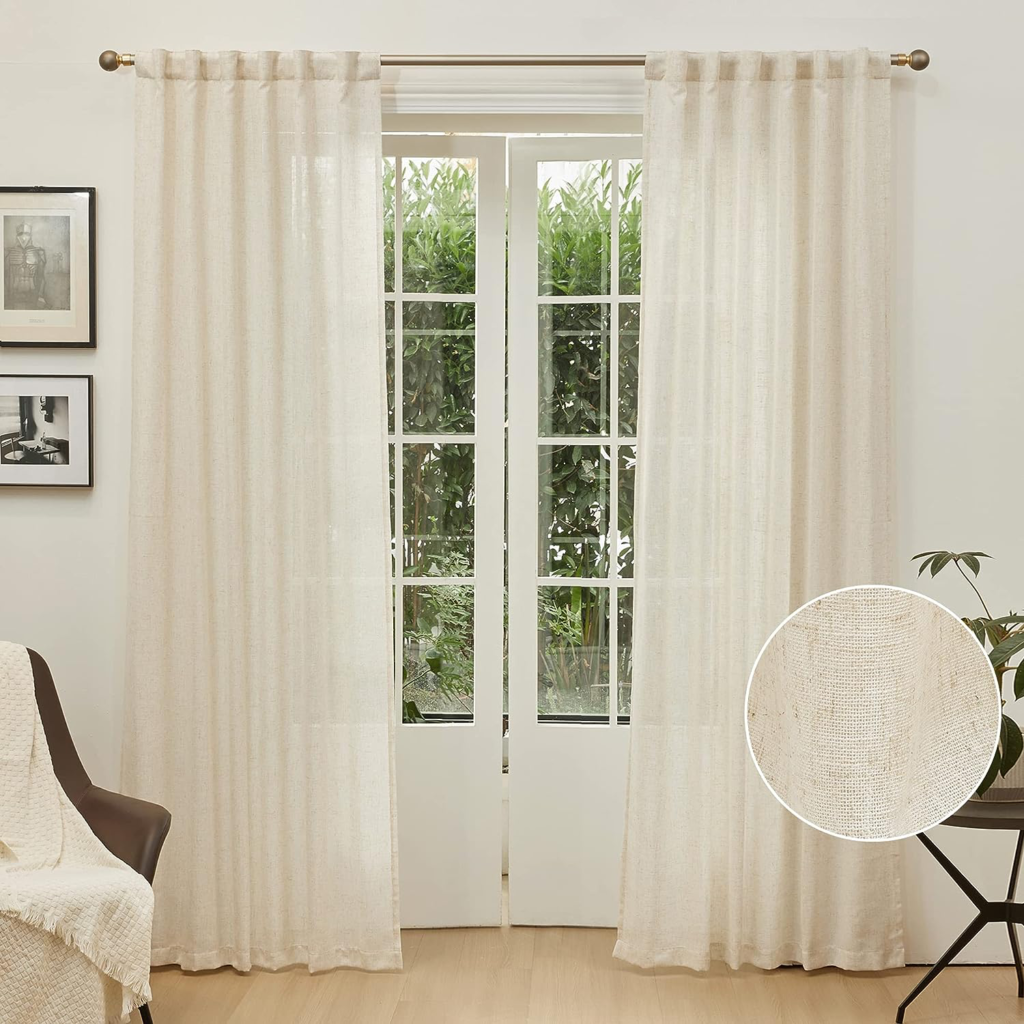
Shop this Boho Curtains from Amazon
It draws the eyes upward, giving the impression that the walls are taller than they actually are. So, don’t be afraid to install your curtain rods a few inches below the ceiling and let your drapes gracefully flow all the way down to the floor.
They offer privacy when needed and help control natural light entering through windows. Opt for curtain styles that are easy to open fully during daylight hours while still affording privacy when closed at night.
Remember that hanging curtains close to the ceiling is not limited only to windows; it can also be applied between spaces within an open plan layout or in rooms with high ceilings but limited square footage. By employing this simple yet effective trick with long flowing curtains in various areas of your small space—be it living room or bedroom—you’ll create an illusion of grandeur that will leave visitors marveling at its perceived size!
12. Scale Down: Choose smaller-scale furniture to fit the proportions of the room.
When it comes to decorating small spaces, one of the most important considerations is the size of your furniture. Choosing smaller-scale furniture can make a world of difference in creating a harmonious and functional space.
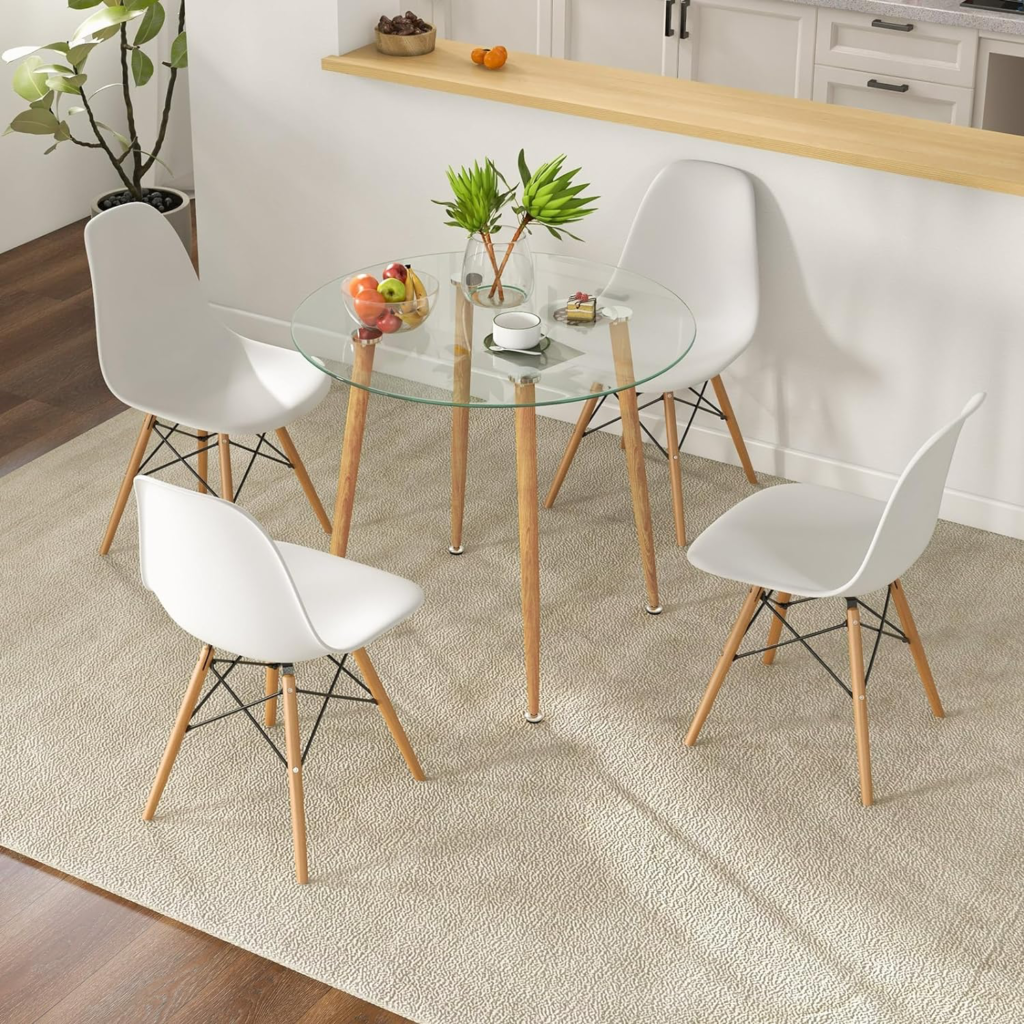
Shop this Dining Table Set for 4 from Amazon
Large, bulky pieces can quickly dominate a small room and make it feel cramped and overcrowded. So, let’s delve into this subtopic and explore some tips on how to scale down your furniture.
Additionally, look for dining chairs with slender frames or even consider using benches along one side of the table to save more space. In bedrooms, optimizing space is crucial since it’s where we spend a significant amount of time relaxing and recharging.
When it comes to beds, opt for platform beds or those with built-in storage compartments underneath. These not only provide extra storage but also eliminate the need for bulky bed frames and box springs.
Don’t forget about storage solutions throughout your home when scaling down furniture. Look for compact dressers with multiple drawers rather than large armoires that may overpower the room visually.
Utilize vertical space by incorporating bookshelves with adjustable shelving options so you can adapt them to fit various items like books, decor items, or even baskets filled with essentials. By choosing smaller-scale furniture that fits the proportions of your room, you create an environment that feels spacious and well-balanced.
13. Minimal Decor: Keep decorations and accessories to a minimum to avoid overcrowding the space.
When it comes to decorating small spaces, one of the golden rules is to keep the decor minimal. This means resisting the urge to fill every nook and cranny with decorations and accessories. While it may be tempting to display your entire collection of trinkets, doing so can quickly make a small space feel cluttered and cramped.
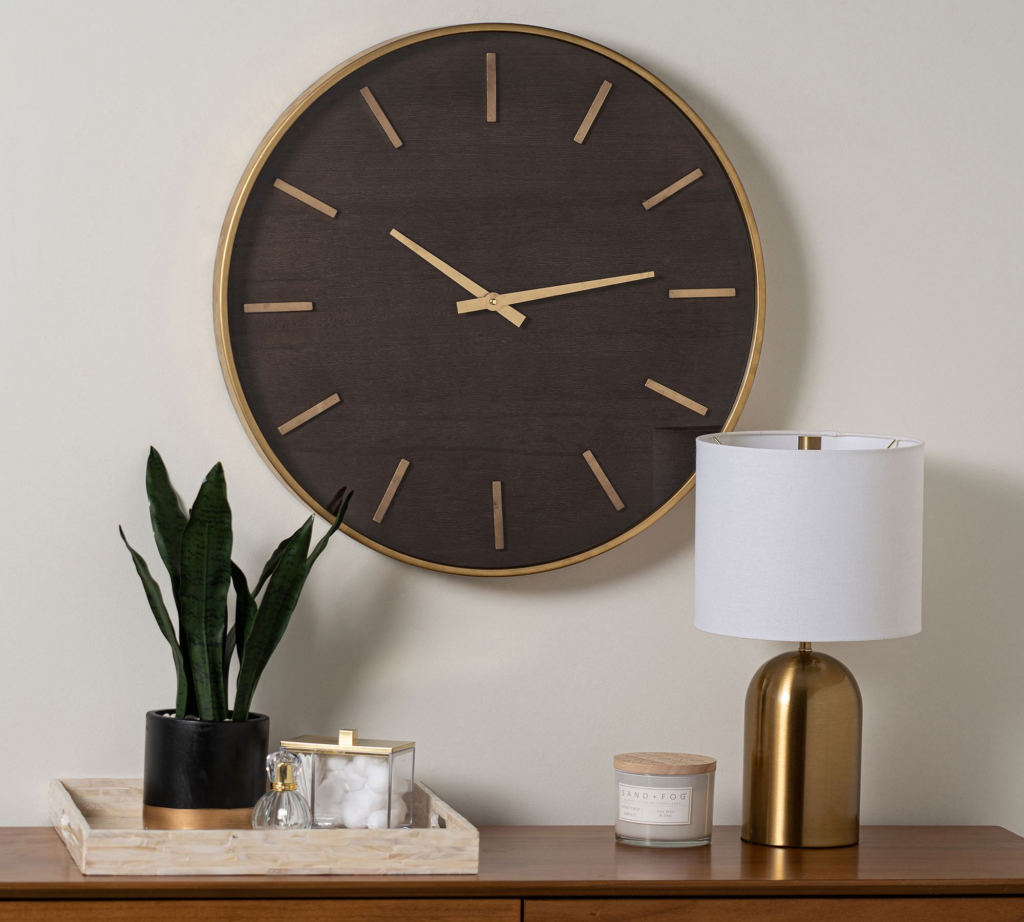
Shop this Beck Round Wall Clock from Pottery Barn
Instead, focus on selecting a few key pieces that truly bring joy or serve a specific purpose in the room. For example, you might opt for a statement artwork that adds personality to the space without overwhelming it.
Wall shelves or floating shelves can hold decorative accents while keeping them off tables and countertops. Additionally, consider multi-functional furniture pieces with built-in storage compartments where you can stash away items like books, magazines, or extra blankets.
Don’t forget about the power of simplicity when it comes to arranging decorative elements in your small space. Instead of scattering multiple smaller accessories throughout the room haphazardly, opt for larger statement pieces strategically placed around the space.
This approach helps create a cohesive look while still allowing for visual interest without overwhelming the eye. Remember that less is often more when it comes to small spaces – keeping decorations and accessories minimal will help maintain an airy and uncluttered ambiance that enhances both style and functionality in your home decor scheme. You can also look at some minimal office home decor here!
14. Lighting: Use a variety of lighting sources, including floor lamps and sconces, to create a well-lit and inviting atmosphere.
When it comes to designing small spaces, lighting plays a crucial role in creating a warm and inviting atmosphere. Adequate lighting not only enhances the overall appeal of a room but also helps to visually expand the space. In small spaces, it’s important to use a variety of lighting sources strategically to maximize brightness and create a cozy ambiance.
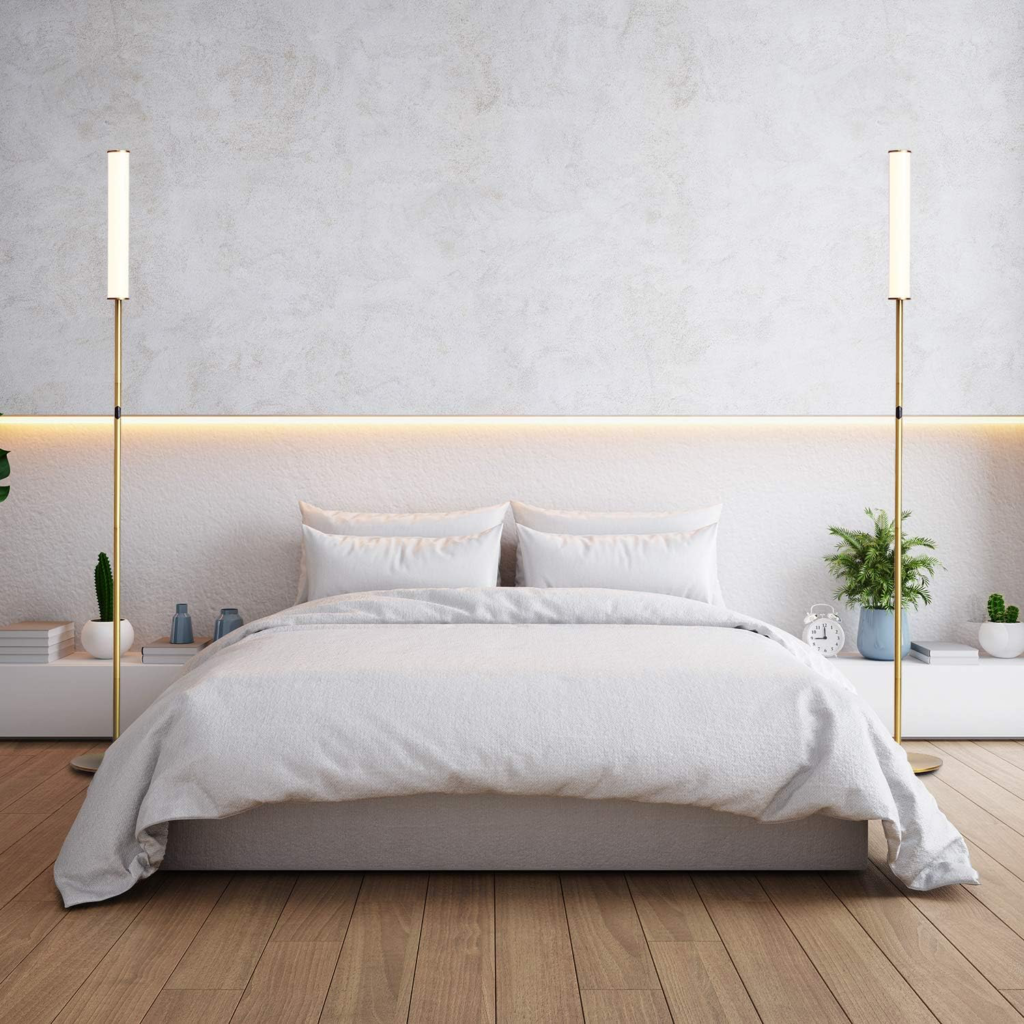
Shop this Cylinder Floor Lamp from Amazon
Floor lamps are a fantastic addition to any small space. They provide both practicality and style, as they can be easily moved around and placed in different corners of the room.
Choose sconces with adjustable arms or adjustable shades so that you can direct the light exactly where you need it most. To create an inviting atmosphere in your small living space, consider utilizing task lighting as well.
Task lighting focuses on specific activities like reading, working on hobbies, or preparing meals. For example, placing a desk lamp on your compact workspace or using under-cabinet lights in your kitchen will add functionality while preventing shadows from engulfing these crucial areas.
Pendant lights over dining tables or kitchen islands not only provide ample light but also serve as stylish focal points. By incorporating various types of lighting sources like floor lamps, sconces, task lights, and decorative fixtures into your small space, you can create an ambiance that is not only well-lit but also visually appealing.
Conclusion
From decluttering and multifunctional furniture to the use of mirrors and light colors, it’s the small things that are key to unlocking the full potential of your compact living space.
Remember, it’s not about the size of your home but the creativity with which you decorate it. Embrace the beauty of minimalism and the art of organization, and you’ll find that less truly can be more. With the right balance of functionality and aesthetics, your small space can become a sanctuary of comfort and style.
So, whether you live in a tiny apartment, a charming cottage, or simply want to optimize a smaller room, these home decor tips will help you achieve a space that’s not only visually pleasing but also conducive to your daily life. Take inspiration from these ideas, and let your small space shine with personality, functionality, and the comforts of home.